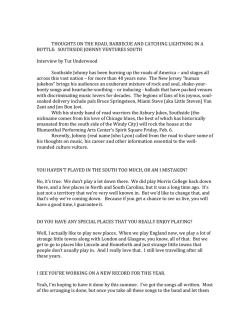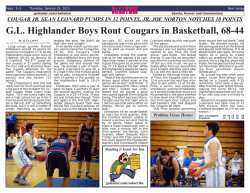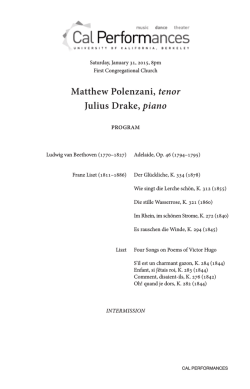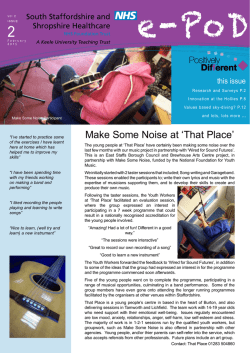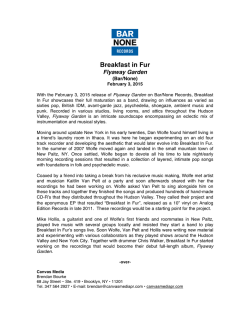
“WHICH SIDE AREYOU ON?”—PETE SEEGER
LABOR SONGS WORKSHEET “WHICH SIDE ARE YOU ON?”—PETE SEEGER 1. Where are the events of this song taking place? 2. What seems to be the problem? 3. How did the narrator’s father make a living? 4. How does the narrator make a living? 5. What “has come in here to dwell,” and according to the song, save these workers? 6. Which side is the narrator on? “I DREAMED I SAW JOE HILL LAST NIGHT”—PAUL ROBESON 1. Where did Joe Hill die? 2. What crime was Hill charged with? 3. Who is responsible for Hill’s death? 4. What part of Hill survives after this death? 5. What is Joe Hill doing now “from San Diego up to Maine?” 6. What side of the labor issue does this song support? 1 LABOR SONGS WORKSHEET (CONTINUED) PETE SEEGER ORAL HISTORY—THE PEEKSKILL RIOTS 1. Who performed at the concert in Peekskill, New York? 2. This concert saved Americans from what? What was going to be done to them and by whom? 3. What did the man in his sixties (a teenager in 1949) say at a press conference in 1999? What had a policeman asked him to do? 4. The Peekskill policemen were joined by what other organizations? 5. The Peekskill police and their allies printed bumper stickers that read “Wake up America, Peekskill did.” Observers quickly noticed that these signs were similar to slogans printed in Germany after what event? 6. How did Americans and President Truman react to the violence at Peekskill? 7. What were the singers at Peekskill accused of supporting? PETE SEEGER ORAL HISTORY—HIGHLANDER AND “WE SHALL OLVERCOME” 1. Who heard Seeger sing “We Shall Overcome” at Highlander? 2. When did Seeger learn the song? 3. Why did it become popular in the late 1950s? 4. Where did they get the idea to change the song? 5. What did Anne Braden tell Seeger that King had said while riding through Tennessee? 2 LABOR SONGS WORKSHEET (CONTINUED) CANDIE CARAWAN—HIGHLANDER AND THE CIVIL RIGHTS MOVEMENT AND GUY CARAWAN —“WE SHALL OVERCOME” 1. Highlander hosted the first meeting of what group? 2. How did Guy and Candie originally meet? What were they doing at the time they met? 3. What songs did Guy teach the workers? 4. Had activists like Candie ever heard these songs before? 5. What is the “Highlander process?” 3 ANOTHER PERSPECTIVE The following passages were taken from James Rorty and Winifred Raushenbush’s “The Lessons of the Peekskill Riots: What Happened and Why?,” an article that appeared in Commentary magazine on October 1, 1950. As the residents of the Peekskill area saw it, the three Robeson concerts held there in 1946, 1947, 1948 could no more be considered mere musical events than a Communist rally in Madison Square Garden. They were primarily fund-raising affairs and Communist demonstrations. (Mrs. Eleanor Roosevelt in one of her columns vigorously objected to Robeson’s utilization of his concerts for political purposes.) Each year Robeson’s supporters in the area were forced to look for a new location. In 1949, Robeson’s sponsors, the Civil Rights Congress, had to hire a field in Cortlandt, neighboring on Peekskill. When local citizens explained to the owners that the Civil Rights Congress was on the Attorney General’s list of subversive organizations, they tried vainly to break their contract. Every year that Robeson appeared, there were protest letters to the Peekskill Evening Star. In 1947, the Peekskill post of the American Legion asked citizens to “refrain from attending.” As a counter to this request, an advertisement in the Evening Star, with twenty-eight signatures, including that of Albert E. Kahn, noted Croton Communist sympathizer, welcomed Robeson to Peekskill. As a top-flight Communist spokesman, Robeson is quite open about his loyalty to the Soviet Union. During the summer of 1949, he was quoted widely in the American press as asserting that he would not fight for this country against Russia. “I love this Soviet people,” said Robeson, “more than any other nation . . . it [is] unthinkable that the Negro people of America or elsewhere in the world could be drawn into war with the Soviet Union.” Robeson’s speeches were featured in the Peekskill Evening Star, which also head lined, as did the metropolitan press, such events as the Communist mass picketing of Judge Medina’s court and the Mindszenty trial in Hungary…. The following portion of a letter also appeared in the article. Vincent Boyle, one of the local leaders of the protest against Paul Robeson’s concert, submitted the letter to the Peekskill Evening Star: ...Quite a few years ago a similar organization, the Ku Klux Klan, appeared in Verplanck [a town near Peekskill] and received their just reward. Needless to say they have never returned. I am not intimating violence in this case, but I believe that we should give this matter serious consideration and strive to find a remedy that will cope with the situation the same way as Verplanck and with the same result that they will never reappear in this area…. 1. According to the citizens of Peekskill, why was Paul Robeson coming to Peekskill? 2. How did Paul Robeson feel about the Soviet Union? 3. What had happened to the Ku Klux Klan when they came to Verplanck (a town near Peekskill)? 4. How does the local’s treatment of the Ku Klux Klan relate to the local’s treatment of Paul Robeson? 4 LABOR SONGS WORKSHEET (ANSWER KEY) “WHICH SIDE ARE YOU ON?”—PETE SEEGER 1. Where are the events of this song taking place? Harlan County (Kentucky) 2. What seems to be the problem? There is trouble between union men and company thugs working for J. H. Blair (Harlan County Police Chief) 3. How did the narrator’s father make a living? He was a miner 4. How does the narrator make a living? He is also a miner 5. What “has come in here to dwell,” and according to the song, save these workers? The union 6. Which side is the narrator on? He is for the union; he supports the workers “I DREAMED I SAW JOE HILL LAST NIGHT”—PAUL ROBESON 1. Where did Joe Hill die? Salt Lake City, Utah 2. What crime was Hill charged with? Murder 3. Who is responsible for Hill’s death? The copper bosses 4. What part of Hill survives after this death? The part that goes on to organize; the spirit of labor organizing 5. What is Joe Hill doing now “From San Diego up to Maine?” Helping defend worker’s rights 6. What side of the labor issue does this song support? Labor; it supports the workers 5 LABOR SONGS WORKSHEET, ANSWER KEY (CONTINUED) PETE SEEGER ORAL HISTORY—THE PEEKSKILL RIOTS 1. Who performed at the concert in Peekskill, New York? Paul Robeson and Pete Seeger 2. This concert saved Americans from what? What was going to be done to them and by whom? From fascism; J. Edger Hoover (head of the FBI) was going to put political dissidents in concentration camps 3. What did the man in his sixties, a teenager in 1949, say at a press conference in 1999? What had a policeman asked him to do? A policemen had asked him to gather rocks to throw at the “commies” at the Peekskill concert 4. The Peekskill policemen were joined by what other organizations? American Legion (military veterans), the Ku Klux Klan, and pro-Nazi German immigrants 5. The Peekskill police and their allies printed bumper stickers that read “Wake up America, Peekskill did.” Observers quickly noticed that these signs were similar to slogans printed in Germany after what event? Kristallnacht (the night the Nazi’s raided Jewish homes and businesses) 6. How did Americans and President Truman react to the violence at Peekskill? Americans were unimpressed, Truman told Hoover “that thing doesn't go in America,” and many Americans actually began to support the singers at Peekskill 7. What were the singers at Peekskill accused of supporting? Civil rights and Soviet communism PETE SEEGER ORAL HISTORY—HIGHLANDER AND “WE SHALL OLVERCOME” 1. Who heard Seeger sing “We Shall Overcome” at Highlander? Rev. Martin Luther King, Jr., Rosa Parks, and Rev. Ralph Abernathy 2. When did Seeger learn the song? Almost ten years earlier, in 1946, from Ziphia Horton (the wife of Myles Horton, Highlander’s director) 3. Why did it suddenly become popular in the late-1950s? Guy Carawan and Frank Hamilton changed the rhythm or beat of the song 4. Where did they get the idea to change the song? Carawan and Hamilton had picked up ideas listening to gospel music at a local Baptist church 5. What did Anne Braden tell Seeger King had said while riding through Tennessee? “’We Shall Overcome,’ that song really sticks with you doesn’t it” 6 LABOR SONGS WORKSHEET, ANSWER KEY (CONTINUED) CANDIE CARAWAN—HIGHLANDER AND THE CIVIL RIGHTS MOVEMENT AND GUY CARAWAN —“WE SHALL OVERCOME” 1. Highlander hosted the first meeting of what group? The group of individuals involved with the civil rights sit-ins 2. How did Guy and Candie originally meet? What were they doing at the time they met? Guy was a volunteer at Highlander teaching songs to civil rights activists. Candie was a participant in the sit-ins in Nashville, and she had come over to Highlander in 1960 for a civil rights workshop. 3. What songs did Guy teach the workers? “I’m Going to Sit at the Welcome Table,” “Keep Your Eyes on the Prize,” and “We Shall Overcome” 4. Had activists like Candie ever heard these songs before? No, they had not heard these “freedom songs” 5. What is the “Highlander process?” Asking questions about what someone is doing and analyzing their current actions and relationships to help them better plan for the future (Candie’s response: “Asking a lot of really, uh, questions that really got you thinking, and got you thinking beyond, you know, what you’ve done so far to think about next steps, and, um, you know, we had breakout sessions on what the meaning of nonviolence is, whether it was a tactic or a philosophy for us, what was our relationship with the adult communities that had already been working to try to dismantle segregation, uh, what about the notion of, uh, if you were arrested, rather than coming out and taking all that bail money, staying in jail to put more pressure on the system.”) 7 ANOTHER PERSPECTIVE (ANSWER KEY) The following passages were taken from James Rorty and Winifred Raushenbush’s “The Lessons of the Peekskill Riots: What Happened and Why?” an article that appeared in Commentary magazine on October 1, 1950: As the residents of the Peekskill area saw it, the three Robeson concerts held there in 1946, 1947, 1948 could no more be considered mere musical events than a Communist rally in Madison Square Garden. They were primarily fund-raising affairs and Communist demonstrations. (Mrs. Eleanor Roosevelt in one of her columns vigorously objected to Robeson’s utilization of his concerts for political purposes.) Each year Robeson’s supporters in the area were forced to look for a new location. In 1949, Robeson’s sponsors, the Civil Rights Congress, had to hire a field in Cortlandt, neighboring on Peekskill. When local citizens explained to the owners that the Civil Rights Congress was on the Attorney General’s list of subversive organizations, they tried vainly to break their contract. Every year that Robeson appeared, there were protest letters to the Peekskill Evening Star. In 1947, the Peekskill post of the American Legion asked citizens to “refrain from attending.” As a counter to this request, an advertisement in the Evening Star, with twenty-eight signatures, including that of Albert E. Kahn, noted Croton Communist sympathizer, welcomed Robeson to Peekskill. As a top-flight Communist spokesman, Robeson is quite open about his loyalty to the Soviet Union. During the summer of 1949, he was quoted widely in the American press as asserting that he would not fight for this country against Russia. “I love this Soviet people,” said Robeson, “more than any other nation . . . it [is] unthinkable that the Negro people of America or elsewhere in the world could be drawn into war with the Soviet Union.” Robeson’s speeches were featured in the Peekskill Evening Star, which also head lined, as did the metropolitan press, such events as the Communist mass picketing of Judge Medina’s court and the Mindszenty trial in Hungary…. The following portion of a letter also appeared in the article. Vincent Boyle, one of the local leaders of the protest against Paul Robeson’s concert, submitted the letter to the Peekskill Evening Star: ...Quite a few years ago a similar organization, the Ku Klux Klan, appeared in Verplanck [a town near Peekskill] and received their just reward. Needless to say they have never returned. I am not intimating violence in this case, but I believe that we should give this matter serious consideration and strive to find a remedy that will cope with the situation the same way as Verplanck and with the same result that they will never reappear in this area…. 1. According to the citizens of Peekskill, why was Paul Robeson coming to Peekskill? To fund-raise and demonstrate for the Communist Party 2. How did Paul Robeson feel about the Soviet Union? Robeson loved the Soviet Union, “more than any other nation” 3. What had happened to the Ku Klux Klan when they came to Verplanck? They had been chased out of town and “never returned” 4. How does the local’s treatment of the Ku Klux Klan relate to the local’s treatment of Paul Robeson? Boyle says that the Peekskill citizens will chase the radical communists out of town just like they chased the radical Ku Klux Klan out of town 8
© Copyright 2025
